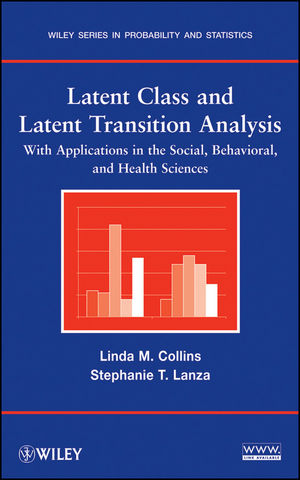About the Book

A modern, comprehensive treatment of latent class and latent transition analysis for categorical data
On a daily basis, researchers in the social, behavioral, and health sciences collect information and fit statistical models to the gathered empirical data with the goal of making significant advances in these fields. In many cases, it can be useful to identify latent, or unobserved, subgroups in a population, where individuals’ subgroup membership is inferred from their responses on a set of observed variables. Latent class and latent transition analysis: With applications in the social, behavioral, and health sciences provides a comprehensive and unified introduction to this topic through one-of-a-kind, step-by-step presentations and coverage of theoretical, technical, and practical issues in categorical latent variable modeling for both cross-sectional and longitudinal data.
Purchase the Book here.
The book begins with an introduction to latent class and latent transition analysis for categorical data. Subsequent chapters delve into more in-depth material, featuring the following:
- A complete treatment of longitudinal latent class models
- Focused coverage of the conceptual underpinnings of interpretation and evaluation of a latent class solution
- Use of parameter restrictions and detection of identification problems
- Advanced topics such as multi-group analysis and the modeling and interpretation of interactions between covariates
The authors present the topic in a style that is accessible yet rigorous. Each method is presented with both a theoretical background and the practical information that is useful for any data analyst. Empirical examples showcase the real-world applications of the discussed concepts and models, and each chapter concludes with a “Points to Remember” section that contains a brief summary of key ideas. All of the analyses in the book are performed using PROC LCA and PROC LTA, the authors’ own software packages that can be run within the SAS® environment. This website contains information on these freely available programs and the book’s data sets, encouraging readers to reproduce the analyses and also try their own variations.
Latent class and latent transition analysis: With applications in the social, behavioral, and health sciences is an excellent book for courses on categorical data analysis and latent variable models at the upper-undergraduate and graduate levels. It is also a valuable resource for researchers and practitioners in the social, behavioral, and health sciences who conduct latent class and latent transition analysis in their everyday work.
Data Analyzed in the Book
The National Longitudinal Study of Adolescent Health
The National Longitudinal Study of Adolescent Health (Add Health; Udry, 2003) is a national, longitudinal study of health and risk behavior among youth, and the influences of social factors on those behaviors. Participants were in Grades 7 through 12 at the initial assessment, which was conducted in 1994-95. To date, three follow-up assessments have been conducted, the first approximately one year later, the second when participants were aged 18-26, and the third when they were aged 24-32. Although the public-use data set includes oversampling of a particular subpopulation, only the core participants (N=6,072), a nationally representative sample, were used for examples in this book. More information about the study and how to obtain the public-use data may be found at http://www.cpc.unc.edu/addhealth.
Youth Risk Behavior Survey, 2005
The Youth Risk Behavior Survey (Centers for Disease Control and Prevention, 2005) monitors national trends in critical health-risk behaviors among youth in 9th through 12th grade. School-based surveys are conducted biannually during the spring of the school year. Behaviors monitored include use of alcohol, tobacco, and other drugs, sexual behavior, and physical activity. The prevalence of obesity, asthma, and suicidal ideation are also monitored. One specific goal of the Youth Risk Behavior Survey is to examine the co-occurrence of health-risk behaviors. Data from the 2005 cohort (N=13,917) were analyzed in this book. More information, as well as downloadable data and computer files, may be found at http://www.cdc.gov/HealthyYouth/yrbs/.
Monitoring the Future, 2004
Monitoring the Future: A Continuing Study of the Lifestyles and Values of Youth (Johnston et al., 2005) is an ongoing, annual study of historical changes in behavior, values, and attitudes in secondary school students in the United States. Each year since 1975, a large, nationally representative sample of 12th-grade students has been surveyed. For examples in this book, the 2004 cohort (N=2,521) was analyzed. More information about the study and how to obtain the downloadable data may be found at http://monitoringthefuture.org.
Free Software & SAS Syntax
PROC LCA and PROC LTA are SAS procedures for LCA and LTA developed by The Methodology Center at Penn State. These add-on procedures are available for download free of charge.
The code used to run the models described in the book is also available so that readers can learn by running the models.
